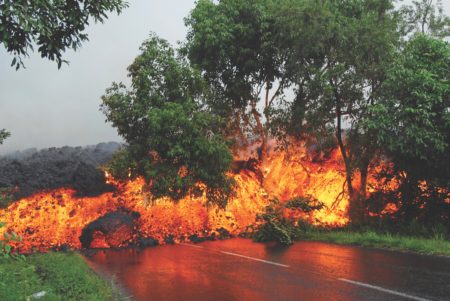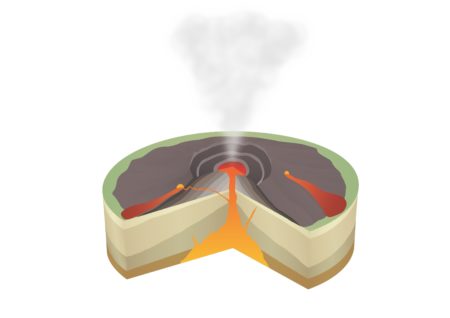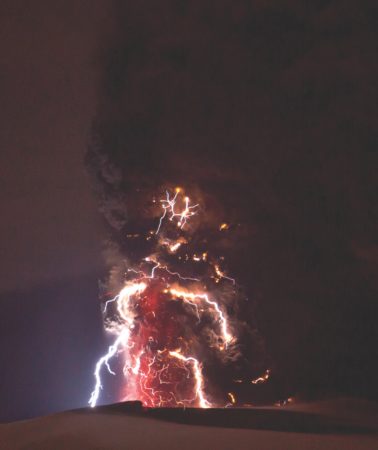What makes volcanoes erupt?
Imagine the Earth as a giant ripe orange. Beneath the thin, dimpled peel is a thick layer of pulp and juice, 90 percent of it liquid. The Earth’s peel is called the lithosphere, a fragile crust of rock—75 to 150 km thick—that floats on a massive sea of impossibly hot, semi-fluid magma extending 5,000 km below the surface.
When German meteorologist Alfred Wegener first proposed his theory of “continental drift” in 1912, people thought he was nuts. How could a colossal hunk of solid rock like Asia or Africa “drift?” As we now know, the continents are indeed solid, but they are fragmented into seven major plates and seven minor plates that eternally jostle for position like buoys on troubled water.
The engines that power this perpetual tectonic dance are giant convection

Lava flow crossing a road during volcanic activity on Reunion, an island in the Indian Ocean, in 2007. This is part of an eruption of the Piton de la Fournaise (Peak of the Furnace) volcano, one of the most active volcanoes in the world. This eruption was the largest at this volcano in the past 100 years.
currents in the Earth’s molten mantle that slowly push magma upward and outward. Wherever rising magma breaks through the thin lithosphere, it’s called volcanism, but the vast majority of volcanoes aren’t the explosive, violent variety. Instead, they are slow-bubbling cauldrons along a 60,000-km underwater seam called the mid-ocean ridge.
The mid-ocean ridge is like an open, oozing wound in the crust where two oceanic plates diverge. The plates are pulled away from each other by the slow and steady convection currents and the gap between them is constantly refilled by thousands of unknown, unnamed underwater volcanoes. As this underwater lava cools, it creates new ocean floor covering 60 percent of the Earth’s surface.
Forget the orange analogy and think of the Earth’s crust like a giant moving walkway in an airport. The walkway emerges from below the floor, travels a set distance and then rolls back underground. The divergent plate boundaries along the mid-ocean ridge are where the Earth’s “moving walkway” begins. The diverging plates are carried along this magma conveyor belt—travelling only three to four centimetres per year—until they meet a plate moving in the other direction.
When two plates converge, something has to give. Ninety percent of earthquakes occur along convergent plate boundaries and so do the world’s biggest and deadliest volcanoes. The prime example is the Ring of Fire, the unbroken string of seismic and volcanic activity that encircles the Pacific Ocean. The Ring of Fire is a giant subduction zone, where oceanic plates “dive” below continental plates and are melted back into magma in the blazing hot forge of the mantle.
Ocean sediment holds tons of water, carbon dioxide, sodium and potassium. When oceanic crust enters the blast furnace of the mantle, these sea-borne elements lower the melting point of surrounding rock, forming a highly gaseous, yet viscous magma that rises quickly toward the surface. If the rising magma reaches an obstacle—an impenetrable hick layer of solid rock—it pools below the surface, building increased pressure as more gaseous, volatile molten materials pushes up from below.

Volcanoes are fed from vast, hot magma chambers deep beneath the Earth’s crust and there are many different types of eruption, both explosive and more gentle, gradual varieties.
And then one day—kabloom! All it takes is a weak point in the cap of rock holding back the magma. On Mount St. Helens, a landslide cleared a swath of rock from the north flank of the mountain, lowering the downward pressure on the boiling pot of magma below. The result was a mind-blowing explosion that produced a monstrous pyroclastic surge—a wall of searing hot fluidized gas, debris and ash—that vaporized everything within a 500-square-kilometre area.
Some of the most famous and infamous eruptions came from subduction zone volcanoes along the Ring of Fire: Tambora in Indonesia, Pinatubo in the Phillipines, Gagxanul in Guatemala, Mount Pelée in Martinique, the list of killer volcanoes goes on. In fact, 400 of the world’s 500 known active volcanoes occur along subduction boundaries.

Volcanic lightning is the release of electric charge that builds up as rising ash mixes with the atmosphere.
But not all famous volcanoes are of the subduction variety. The volcanoes of the Hawaiian Islands are an example of something called hot spot volcanism. Think back to those powerful convection currents in the mantle that push magma upward toward the crust. In certain “hot spots” around the planet, convection currents are able to ooze magma to the surface without much resistance.
Picture the hot spot under the Hawaiian Islands as a giant tube of toothpaste. Squeeze the tube and the little dollop of paste becomes the first Hawaiian Island, Kauai. Now keep the tube in the same place while the ocean plate travels a few hundred kilometers northwestward. Squeeze the tube again and you’ve created the second island, Oahu. Hawaii, the Big Island, is still sitting over that magma pump, fueling magnificent, slow-boiling eruptions that are literally building the island.
The intensity and duration of a volcanic eruption depends mostly on the consistency of the magma rising to the surface and the obstacles preventing the magma from reaching the surface. Subduction volcanoes are so ear-poppingly explosive because the magma fueling them is loaded with gas bubbles and silica from sea floor sediments. The high silica content makes the magma more viscous, preventing gas bubbles from easily escaping. The result is like shaking a bottle of soda. When that pressure is released—pop!
The hot spot volcanoes of Hawaii, on the other hand, feature highly fluid magma formed from basaltic rock with low silica content. The “watery” quality of Hawaiian magma allows gas to escape easily. After an initial, relatively calm eruption, Hawaiian volcanoes spew majestic fountains of lava forming large river-like flows that creep slowly to the sea.
For more science and technology articles, pick up the latest copy of How It Works from all good retailers or from our website now. If you have a tablet or smartphone, you can also download the digital version onto your iOS or Android device. To make sure you never miss an issue of How It Works magazine, subscribe today!





